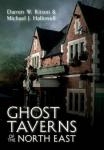
Darren W Ritson and Michael J Hallowell, authors of The South Shields Poltergeist and The Haunting of Willington Mill, as well as many other books on paranormal themes written separately, join forces once again to present their researches into haunted pubs in the north east of England, of which there are a great many (actually this is a reissue of the authors’ 2009 Ghost Taverns: An Illustrated Gazetteer of the North East). Pubs as a social setting have traditionally been a natural venue for storytelling, and this collection shows how varied, and yet often how similar, those stories can be.
Before getting to the haunted taverns, there are musings on the history of drinking and smoking (the two activities until recently heavily intertwined), a list of pubs and brewers in South Shields in 1834, and another of pubs in Jarrow in 1900. The gazetteer contains short entries interspersed with longer ones, some of the latter recounting investigations with local ghost-hunting groups at significant venues. A number of the pubs have appeared in Hallowell’s Ales and Spirits and Ritson’s Ghost Hunter and In Search of Ghosts, but are updated here. Normally such guides are well illustrated, but this volume has almost no photographs, apart from a small selection on a single page. This is fine though, as it allows more space for text.
Each entry is graded with a rating from 1 to 10 as an estimate of how significant the establishment is, not as a pub per se, but as a haunted site. The authors acknowledge that the criteria are flexible and subjective; however, the grades are not of course based on how haunted the place is, but how haunted it is claimed to be, that is, whether there is a good story with perhaps some grounding in reality – though with ghost narratives it is hard to tell the point at which truth ends and fiction begins. This is particularly so with commercial establishments, where there is often a suspicion that exaggeration and even invention is at work to attract punters (to be fair there are a couple of pubs in the book which have been given pseudonyms, so they can’t be accused of overegging their paranormal puddings).
Ritson and Hallowell know their stuff, but as so often with this type of book, little help is given to the reader who wants to employ it as a field guide. Premises are listed in alphabetical order, irrespective of location, so if you want to check which ones are in a given area, you are obliged to thumb through the lot. It would have helped to have had them grouped geographically, or at least provide an index with locations included.
As with Ritson and Hallowell’s other works, this is very readable, though with a frequent waggish reaching after ‘stylish writing’: books aren’t “books” when they can be “tomes”, and drinks are frequently “beverages” which are “ingested”. To be French is, naturellement, to be “of Gallic extraction”, etc etc. Sometimes their tongue-in-cheek prose leads them astray. “Roman legionnaires” is what happens when the authorities in the Italian capital don’t keep their water tanks clean; it’s Roman legionaries.* Mike’s brain structure appears to be peculiar: for him, the association between pubs and ghosts (to be precise, “the relationship between drinking establishments and denizens of the netherworld”) grew naturally, without him noticing, in his cerebellum. I think perhaps they mean in his cerebrum.
The authors certainly know how to amuse. They say of the South Shields Police Club that “the bar was popular, but so too were the toilets, for obvious reasons”. I think they are saying that drinking a lot requires frequent visits to the lavatory, but there could be other – equally obvious – reasons for the toilets being popular. The agog reader is left wondering exactly what a Saturday night at the South Shields Police Club looks like. One pub does a cracking “stake and ale pie”, which could be handy if vampires drop by while in the middle of dinner (or partaking of one’s repast, as Darren and Mike might put it).
Despite the eccentric use of language, if you ever have cause to go drinking in the area, this is a useful handbook to take with you. It is jammed with information which combines affection for the area with enthusiastic first-hand enquiry. The result is a deep knowledge both of alcohol, and the local boozers which have an interesting story attached.
Over the centuries the number of pubs in England has declined, and the trend has accelerated in recent years. At the same time the character of many of the survivors has altered, a bland homogenised uniformity often taking over from the homely spit and sawdust of the past, as landlords and landladies are replaced by managers employed by chains. But many pubs with character still exist, and there is no doubt that ghost stories will continue to emerge, especially while publicans find that they help to attract customers.
Given the amount of on-the-spot research carried out, it seems unlikely that the authors will make a great deal of profit from their tome, but on the other hand presumably they are in the enviable position of being able to offset their expenses against tax. Subsidised eating and drinking sounds rather attractive, and Ritson and Hallowell are to be applauded for finding such an elegant way to combine business and pleasure.
*To be fair to Darren and Mike, shortly after I wrote this review I heard Jack Dee on I'm Sorry I Haven't a Clue also refer to "Roman legionnaires". It must be infectious. Even though Shelley used the term “legionaires” in relation to the Roman legions, it seems poor style.

